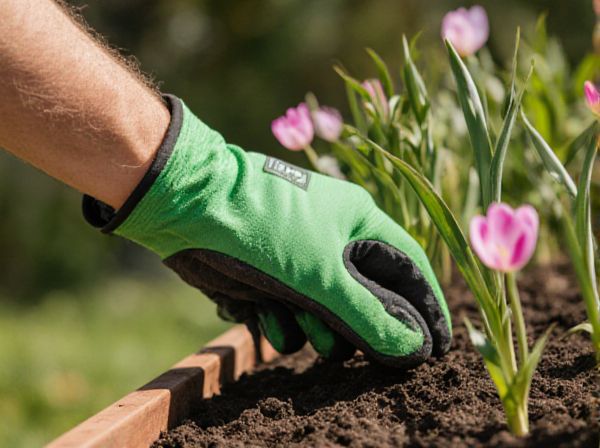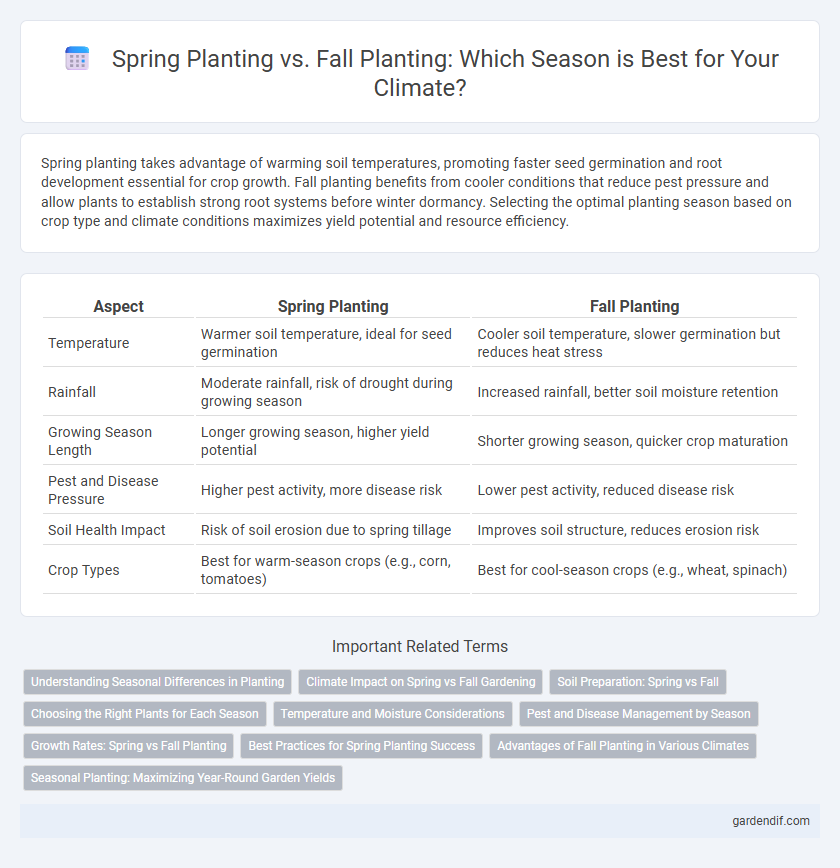
Spring planting vs Fall planting Illustration
Spring planting takes advantage of warming soil temperatures, promoting faster seed germination and root development essential for crop growth. Fall planting benefits from cooler conditions that reduce pest pressure and allow plants to establish strong root systems before winter dormancy. Selecting the optimal planting season based on crop type and climate conditions maximizes yield potential and resource efficiency.
Table of Comparison
| Aspect | Spring Planting | Fall Planting |
|---|---|---|
| Temperature | Warmer soil temperature, ideal for seed germination | Cooler soil temperature, slower germination but reduces heat stress |
| Rainfall | Moderate rainfall, risk of drought during growing season | Increased rainfall, better soil moisture retention |
| Growing Season Length | Longer growing season, higher yield potential | Shorter growing season, quicker crop maturation |
| Pest and Disease Pressure | Higher pest activity, more disease risk | Lower pest activity, reduced disease risk |
| Soil Health Impact | Risk of soil erosion due to spring tillage | Improves soil structure, reduces erosion risk |
| Crop Types | Best for warm-season crops (e.g., corn, tomatoes) | Best for cool-season crops (e.g., wheat, spinach) |
Understanding Seasonal Differences in Planting
Spring planting benefits from warming soil temperatures and increased daylight, promoting rapid seed germination and vegetative growth. Fall planting takes advantage of cooler temperatures and moist soil conditions, allowing root systems to establish before winter dormancy. Understanding these seasonal differences helps optimize crop yield and plant health by aligning planting times with specific growth requirements and climatic conditions.
Climate Impact on Spring vs Fall Gardening
Spring planting benefits from warming soil temperatures that accelerate seed germination and plant growth, reducing frost risk and supporting early crop development. In contrast, fall planting leverages cooler temperatures and increased moisture, which enhance root establishment and improve plant resilience to winter stresses. Climate variability, including shifting frost dates and precipitation patterns, critically influences the success rates and species selection for both spring and fall gardening.
Soil Preparation: Spring vs Fall
Spring planting requires thorough soil warming and moisture management to ensure seed germination and root development, often involving light tilling and nutrient amendments to promote rapid growth. Fall planting emphasizes deep soil aeration and organic matter incorporation to improve winter soil structure and microbial activity, enhancing nutrient availability for early spring crops. Proper soil pH adjustment during fall prepares the soil for spring planting, while spring preparation focuses on correcting nutrient deficiencies revealed by soil tests.
Choosing the Right Plants for Each Season
Spring planting favors annuals like tomatoes, peppers, and beans that thrive in warming soil and longer daylight hours, while fall planting suits cool-season crops such as broccoli, kale, and carrots that benefit from cooler temperatures and reduced pest activity. Selecting plants resistant to seasonal pests and adaptable to soil moisture fluctuations enhances growth success and yield. Timing the planting according to frost dates and regional climate zones optimizes plant development and harvest quality.
Temperature and Moisture Considerations
Spring planting benefits from warming soil temperatures that promote seed germination and root development, while adequate moisture from spring rains supports early growth. Fall planting takes advantage of cooling temperatures that reduce plant stress and often relies on residual moisture in the soil to sustain seedlings through winter dormancy. Temperature fluctuations and soil moisture availability critically influence seedling survival and crop yield outcomes in both planting seasons.
Pest and Disease Management by Season
Spring planting reduces the risk of soil-borne diseases by allowing fields to dry and warm, which inhibits pathogen survival. Fall planting can increase pest pressures from overwintering insects and fungal diseases due to cooler, moist conditions favorable for their development. Effective pest and disease management requires monitoring seasonal climate patterns to select optimal planting times that minimize infestations and infections.
Growth Rates: Spring vs Fall Planting
Spring planting typically results in faster initial growth rates due to warmer soil temperatures and longer daylight hours, which enhance seed germination and root development. Fall planting benefits from cooler temperatures that reduce heat stress on seedlings and often leads to stronger root systems before winter dormancy. Growth rates in spring can be quicker, but fall planting often provides plants with a more robust foundation for early growth in the following season.
Best Practices for Spring Planting Success
Selecting crops suited to spring's warming soil temperatures enhances seed germination and early growth, while ensuring soil moisture is optimal prevents drought stress. Employing raised beds improves drainage and warms the soil faster, benefiting root development during the critical early growth stages. Regularly monitoring soil nutrient levels and applying balanced fertilizers tailored to spring crops supports robust plant health and maximizes yield potential.
Advantages of Fall Planting in Various Climates
Fall planting offers several advantages across diverse climates, promoting stronger root development during cooler temperatures and reducing water stress compared to spring planting. In temperate zones, fall planting ensures seedlings establish before winter dormancy, leading to earlier harvests and improved resilience against spring pests. Cooler soil and air conditions during fall also decrease disease incidence, enhancing overall plant health and yield.
Seasonal Planting: Maximizing Year-Round Garden Yields
Spring planting leverages warming soil temperatures to promote rapid seed germination and vigorous plant growth, ideal for crops like tomatoes and peppers. Fall planting takes advantage of cooler temperatures and increased moisture, extending the growing season for hardy vegetables such as kale and broccoli. Balancing both seasonal strategies ensures continuous harvests, maximizes garden productivity, and optimizes use of space across varying climatic conditions.
Spring planting vs Fall planting Infographic

 gardendif.com
gardendif.com